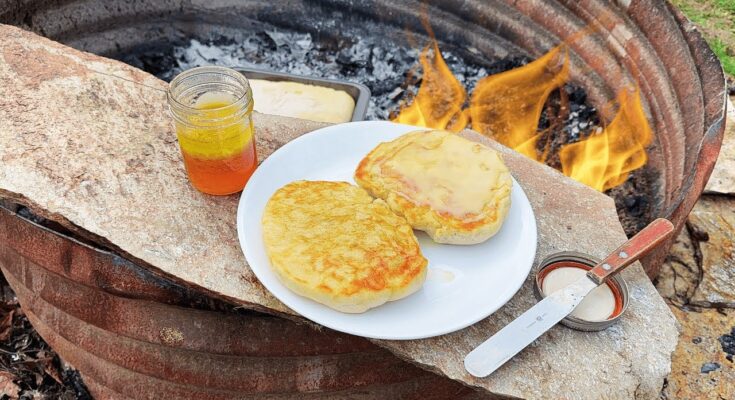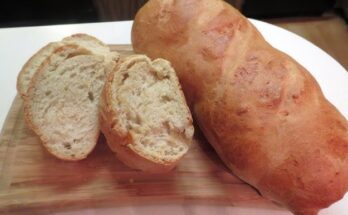Outdoor Boys Bread Recipe: Bread-making is one of those timeless outdoor activities that bring people together, especially around a campfire. The Outdoor Boys Bread Recipe became popular thanks to the Outdoor Boys YouTube channel, where they make rustic, golden-brown bread in the great outdoors using simple ingredients and old-school methods. This recipe isn’t just about food—it’s about the experience: the crackling of the fire, the smell of baking dough, and that first warm bite under the open sky.
Unlike complicated bakery recipes, this one focuses on simplicity and adaptability. Whether you’re out camping, overlanding, or just cooking in your backyard, you can easily make this bread with minimal tools. The beauty of the Outdoor Boys Bread is that it’s foolproof, beginner-friendly, and incredibly satisfying to make.
The process involves mixing, kneading, and baking either in a Dutch oven over a campfire or in a regular oven at home. You’ll get a crusty, golden exterior with a soft, fluffy inside—perfect for pairing with stews, soups, or even a bit of butter and honey.
What makes this recipe stand out is how it captures that back-to-nature feeling. You don’t need fancy mixers or ovens—just your hands, a bowl, and a good fire. It’s rustic cooking at its best, giving you not just food but an experience you’ll remember every time you catch that whiff of freshly baked bread outdoors.
Ingredients You’ll Need
Before you head outdoors or start in your kitchen, let’s get your ingredients and tools ready. The magic of this recipe is that it uses simple, everyday ingredients, yet delivers the most comforting, artisan-style bread.
Basic Ingredients:
- 4 cups all-purpose flour (or bread flour for extra chewiness)
- 2 teaspoons salt
- 2 teaspoons sugar (optional, for slight sweetness)
- 1 packet (2 ¼ tsp) active dry yeast
- 1 ½ cups warm water (around 105–110°F)
- 1 tablespoon oil or melted butter (optional, for richer flavor)
Optional Add-Ons for Flavor:
- 1 tablespoon honey or maple syrup – adds a rustic sweetness.
- 1 teaspoon garlic powder or herbs – for a savory touch.
- ½ cup shredded cheese – makes a hearty, cheesy loaf.
- ¼ cup nuts or seeds – adds texture and nutrition.
Equipment Checklist:
- Mixing bowl
- Wooden spoon or your hands
- Clean surface for kneading
- Dutch oven, cast iron skillet, or camping pot with lid
- Campfire or oven
- Cloth or plastic wrap for covering dough
Everything here is easy to carry and perfect for outdoor use. That’s what makes this bread so appealing—it’s designed to work anywhere, even miles away from a kitchen.
Step-by-Step Guide to Making Outdoor Boys Bread
Now that your ingredients are ready, let’s dive into the fun part—the baking process! Follow these easy steps to make your outdoor bread turn out perfectly every time.
Step 1 – Preparing the Dough
Start by mixing 2 cups of all-purpose flour, 1 tablespoon of sugar, 1 teaspoon of salt, and 2 teaspoons of baking powder (or 1 teaspoon of yeast if you prefer a fluffier loaf). Gradually add ¾ cup of water and 2 tablespoons of oil or melted butter. Stir until the dough starts to come together.
Step 2 – Kneading for Perfect Texture
Transfer the dough onto a floured surface and knead it for about 5–8 minutes. You want it to feel soft and stretchy — not too sticky. This step helps build the gluten, giving the bread that satisfying chew.
Step 3 – Letting the Dough Rise
If you’re using yeast, place the dough in a covered bowl and let it rest for about 45–60 minutes, or until doubled in size. If using baking powder, a short 10–15 minute rest will do just fine.
Step 4 – Baking Over a Campfire or Oven
Shape the dough into a round or long loaf. For a rustic campfire bake, wrap it around a clean stick or place it in a cast-iron pan over hot coals, turning occasionally. Alternatively, bake in an oven at 375°F (190°C) for 20–25 minutes until golden brown.
Step 5 – Cooling and Serving
Once baked, let the bread cool slightly before slicing. Enjoy it warm with butter, honey, or jam — simple, hearty, and perfect for outdoor adventures!
Tips for Making Bread Outdoors
Making bread outdoors is slightly different from doing it in your kitchen. There are elements like temperature, humidity, and wind that can affect how your bread turns out. Here are some essential tips to help you bake like a pro in the wild.
How to Control Temperature When Cooking Outside
Temperature control is key. If your fire is too hot, the bread might burn on the outside before the inside cooks through. If it’s too low, it can stay doughy. The trick is to use campfire coals, not open flames. Coals provide even, consistent heat—perfect for baking.
You can test the temperature by holding your hand about 6 inches above the fire. If you can hold it there for 5–6 seconds, it’s just right for baking. Rotate your Dutch oven or skillet halfway through to ensure even cooking.
Using Dutch Ovens or Cast Iron Skillets
Dutch ovens are ideal for outdoor baking because they hold heat evenly and mimic a real oven. Cast iron skillets also work great for flatbreads or smaller loaves. Always preheat your cookware before adding the dough—it helps create that beautiful golden crust.
When using a Dutch oven, don’t forget to add a few coals on top of the lid. This creates a surround heat effect, baking your bread evenly from all sides. If you’re using a skillet, cover it with foil or another pan to trap heat.
Campfire Safety and Efficiency
Safety should always come first. Clear the area around your fire pit, keep a bucket of water nearby, and use long tongs or heatproof gloves when handling hot equipment. Build your fire with hardwood like oak or hickory—they burn longer and produce steady heat.
Also, be patient. Campfire baking is more art than science. The first loaf might not be perfect, but with practice, you’ll learn how to control your fire like a true outdoor chef.
Variations of Outdoor Boys Bread
One of the best things about this recipe is its flexibility. Once you’ve mastered the basic version, you can easily tweak it to make different kinds of bread for any occasion. Let’s explore some delicious variations you can try next time you’re outdoors.
Sweet Campfire Bread
Craving something sweet after dinner? Turn your bread into a dessert loaf by adding 2 tablespoons of sugar or honey, a teaspoon of cinnamon, and a handful of raisins or chocolate chips. The warmth of the fire enhances the sweetness, making it perfect for breakfast or as a treat by the firelight.
You can even drizzle some icing made from powdered sugar and water once the bread cools. It’s simple yet incredibly satisfying.
Savory Herb Bread
For a more flavorful, dinner-style loaf, mix in garlic powder, dried herbs, or shredded cheese to the dough. This savory variation pairs beautifully with soups, stews, and grilled meats. The smell of herbs wafting through the campsite will attract everyone around!
Try combinations like rosemary and olive oil, or garlic and cheddar. They add depth and make your bread a meal on its own.
No-Yeast Quick Bread
Don’t have yeast? No problem! You can make a no-yeast quick bread using 2 teaspoons of baking powder instead. This version doesn’t require rising time and can be baked right after mixing. The texture is denser, but it’s still tasty and perfect for camping when you want something fast.
Storing and Reheating Outdoor Bread
After putting in all that work to bake your delicious outdoor bread, you’ll definitely want to make sure it stays fresh for as long as possible. The good news is that rustic breads like this one can last several days if stored properly, even outdoors.
How to Keep It Fresh
Once your bread has cooled completely, wrap it tightly in a clean cotton towel or parchment paper. Avoid plastic bags when you’re camping, as they trap moisture and can make the crust soggy. A breathable cloth keeps the bread’s outer crust crisp while maintaining the soft inside.
If you’re at home, you can also store it in a bread box or airtight container at room temperature for up to three days. For longer storage, slice the loaf and freeze it. When ready to eat, just toast or reheat over a campfire for that fresh-baked taste again.
When you’re outdoors, store your bread in a cool, shaded spot. If camping in warmer climates, use a cooler bag (without direct ice contact) to preserve freshness. This will keep your loaf from drying out or becoming stale too quickly.
Reheating Methods for Camping Trips
Reheating is simple, and it actually revives the bread’s flavor and texture. Here’s how:
- Over a Campfire: Wrap slices in foil and place them on a grill rack near the coals for about 5 minutes on each side. The heat will make the crust crispy again.
- On a Skillet: Heat a cast iron pan over the fire and warm your bread slices for 2–3 minutes per side until slightly toasted.
- In a Dutch Oven: If you’ve stored your bread in larger pieces, wrap them in foil and reheat inside the Dutch oven with coals on top for 10 minutes.
Each method brings back that rustic flavor you love, as if you just baked it fresh again. Warm bread outdoors is one of life’s simplest and most comforting pleasures—especially when shared with family or friends under the open sky.
Common Mistakes and How to Avoid Them
Even though this recipe is straightforward, there are a few common mistakes that can make or break your outdoor bread. Let’s look at these pitfalls and how to steer clear of them.
Over-Kneading or Under-Kneading
Kneading builds gluten—the protein that gives bread its structure. If you under-knead, your bread may turn out flat and crumbly. If you over-knead, it can become tough and chewy.
The best way to tell if you’ve kneaded enough is to do the “windowpane test.” Stretch a small piece of dough between your fingers; if it forms a thin, translucent film without tearing, it’s perfect. Aim for about 8–10 minutes of kneading for most doughs.
Remember, this is outdoor cooking—it’s not about perfection but about feel. With each bake, you’ll get a better sense of the dough’s behavior.
Managing Moisture and Heat
Another common issue is dough that’s too wet or dry. Outdoors, humidity can affect your ingredients more than you might think. Always bring a bit of extra flour and water to adjust as needed.
If your dough sticks to your hands or bowl, add flour one tablespoon at a time. If it feels stiff or cracks while shaping, sprinkle some water. Bread dough should feel smooth, elastic, and slightly tacky, not sticky or crumbly.
When baking over fire, control your heat carefully. Too much direct flame can burn the crust before the inside cooks. Aim for steady, glowing coals, and check your bread occasionally to rotate or adjust distance from heat.
Patience is the secret ingredient here—rushing the rise or baking process can ruin an otherwise perfect loaf.
Health Benefits of Homemade Bread
You might be surprised to learn that homemade outdoor bread isn’t just delicious—it’s healthier than most store-bought options. Here’s why making your own loaf is a win for your taste buds and your well-being.
Nutritional Advantages
When you bake bread yourself, you control every ingredient. There are no preservatives, artificial flavorings, or excess sodium—just flour, yeast, water, and love. Compared to mass-produced loaves that often contain emulsifiers and stabilizers, homemade bread offers pure nutrition.
You can also boost the nutritional value by experimenting with whole wheat flour, seeds, nuts, or oats. These add fiber, protein, and essential minerals like magnesium and iron.
Another bonus? You can adjust sugar and salt levels according to your dietary preferences. If you’re watching carbs or sodium intake, this bread can easily fit into your balanced outdoor meal plan.
Comparing Homemade vs. Store-Bought Bread
| Feature | Homemade Bread | Store-Bought Bread |
|---|---|---|
| Ingredients | Natural, simple, no preservatives | Often includes additives and stabilizers |
| Flavor | Fresh, earthy, customizable | Processed and uniform |
| Texture | Soft inside, crisp crust | Usually soft, less texture |
| Shelf Life | 2–3 days (fresh) | 7–10 days (preserved) |
| Nutrition | Higher fiber, customizable | May contain hidden sugars or sodium |
The biggest difference, though, is satisfaction. There’s something deeply rewarding about eating bread you made yourself—especially outdoors. It’s wholesome, honest food that nourishes both body and spirit.
Serving Suggestions
Your Outdoor Boys Bread is so versatile that it can complement almost any meal. Whether you’re camping, hiking, or cooking at home, here are some tasty and creative ways to enjoy your fresh loaf.
Pairing Ideas for Meals
- Breakfast: Toast it over the fire and top with butter, honey, or jam. Pair with scrambled eggs or bacon for a hearty start to your day.
- Lunch: Use thick slices for sandwiches—try grilled cheese, ham and mustard, or roasted veggies with hummus.
- Dinner: Serve alongside soups, stews, or chili. The crusty bread soaks up all those rich flavors beautifully.
- Dessert: Sprinkle with cinnamon sugar and toast for a quick, sweet treat.
Fun Outdoor Serving Styles
If you’re camping with friends, slice the loaf and serve it on a wooden cutting board for a rustic presentation. Wrap slices in parchment paper for easy sharing.
For family cookouts, use your bread as a base for campfire pizzas—spread tomato sauce, cheese, and toppings, then grill for 5 minutes. Or, make stuffed bread by slicing it open and adding melted cheese, herbs, and garlic before reheating over coals.
Every serving idea adds a fun, creative touch to your outdoor meals while showcasing your freshly baked bread.
FAQs about Outdoor Boys Bread Recipe
1. Can I make this bread without yeast?
Yes! Substitute baking powder for yeast to make a quick, no-rise bread. It will be denser but still delicious.
2. How do I bake this bread without an oven?
Use a Dutch oven or cast iron skillet over a campfire with hot coals. Rotate occasionally for even baking.
3. What flour is best for campfire bread?
All-purpose flour works great, but bread flour gives a chewier texture. For a healthier option, mix in whole wheat flour.
4. How long does the bread stay fresh outdoors?
When wrapped in a cloth and stored in a cool, dry place, it stays fresh for 2–3 days.
5. Can I add nuts or dried fruits?
Absolutely! Chopped nuts, raisins, or cranberries add texture and flavor. Just mix them into the dough before baking.
Conclusion
The Outdoor Boys Bread Recipe is more than just a way to make bread—it’s a connection to nature, family, and the timeless art of outdoor cooking. From the first rise to the final golden crust, every step teaches patience, care, and appreciation for simple ingredients.
This bread embodies everything beautiful about outdoor life: warmth, togetherness, and creativity. Whether you’re around a campfire or in your backyard, the process of kneading, baking, and breaking bread with others is a powerful reminder of how food brings people closer.
So next time you’re out exploring or camping under the stars, remember to pack a little flour, yeast, and time—you’ll end up with a loaf that not only fills your stomach but warms your heart too.



